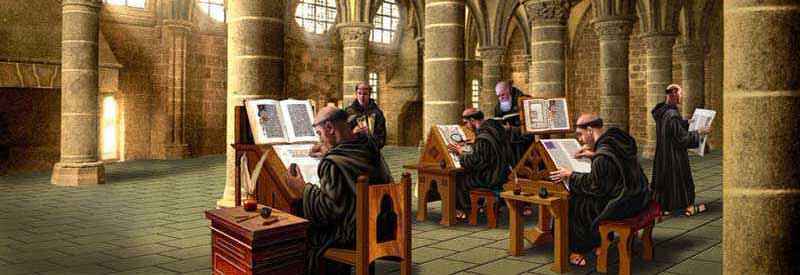
Premise 1 : Ancient writers considered the Bible sacred, and the strictest safeguards were practiced to assure accuracy
The word Bible is derived from the Latin word “biblia” which literally means “the books”. The Bible is a collection of 66 books written by around 40 authors from different backgrounds, and writing styles over a period of about 2,000 years.
Since there was no printing press in ancient times the books of the Bible were hand written on scrolls made of Papyrus, parchment, leather, or vellum. The famous Dead Sea Scrolls are a collection of 15,000 of these scrolls written on parchment—some copied as early as 250 B.C. These scrolls along the 51,000 other ancient manuscripts of the Bible were mostly copied by Scribes.

A Scribe was a member of a learned class in ancient Israel whose professional occupation was to study, copy, and edit Scripture. The two central objectives for scribes were to:
- Copy Sacred Scripture on scrolls to be read in synagogues and churches, and to be preserved for posterity.
- Preserve the integrity of Sacred Text and protect it against corruption, additions, or deletions.
The Scribes As Professionals And Their Dedication To Sacred Scripture
It is scarcely possible to overstate the importance of early scribes. Scribes were usually skilled professionals valued because they could read and write, and edit which were not common skills in the ancient world.
The term sopher is used 64 times in the Bible was given to Bible scribes meaning “Scripture Specialist“. Those who were responsible for the normal transmission of the sacred documents were the ones who knew the Scriptures by heart due to their education and the frequency of writing the same books repeatedly.
Many scribes were capable of writing out the whole of Scripture by memory. But for the sake of accuracy even this was not allowed
Many scribes wrote in “Scriptoriums” which were professional spaces dedicated to the art of copying from dictation. Jewish scribes were some of the most skilled in the world, and were renowned for the dedication to careful copying.

Jewish scribes would say they felt the “weight of heaven” when copying the Bible, because it contained the sacred “Torah” or Law of God. One of the books they copied the most was Deuteronomy which literally means “Copy or Repeated Law” which contains this passage that they would have transcribed countless times:
You shall not add to the word which I am commanding you, nor take away from it, so that you may keep the commandments of the Lord your God which I am commanding you.
Deuteronomy 4:2
Scribes felt that the severest judgement of God was reserved for anyone who misquoted, misallocated, or disrespected the “Law of God” and believed that God himself was watching over their shoulder as they transcribed it. Here is a fragment found with the Dead Sea Scrolls written by a scribal elder to his apprentice.
“My son, be careful, because your work is the work of heaven; should you omit (even) one letter or add (even) one letter, the whole world would be destroyed.”
(quoted in Tov, SPA, 26)
Copying was tedious work done with a qualified system developed to preserve ancient textual accuracy with precision, and accountability. Copies were usually signed in colophons, and a signed copy could be traced to its writer for credit or reproof, or to check a source.
They were so meticulous that they counted all the paragraphs, words and even letters, so they could know by counting, if they had done it perfectly.
They knew the middle letter of each book so they could count back and see if they had missed anything.
Various rabbinic rules regarding transmission procedures such as the selection of writing materials, preparation of leather, error correction, transcribing of divine names, storage and reading of scrolls, and measurements of sheets, columns, and margins all reveal the reverence with which rabbinic scribes approached the biblical text.
Josh McDowell, Sean McDowell; Evidence That Demands a Verdict (p. 97). Thomas Nelson
Here are some of the standards that were considered absolutely mandatory:
- They could only use clean animal skins, both to write on, and even to bind manuscripts
- Each column of writing could have no less than forty-eight, and no more than sixty lines
- The ink must be black, and of a special recipe
- They must verbalize each word aloud while they were writing
- They must wipe the pen and wash their entire bodies before writing the word “Jehovah,” every time they wrote it
- There must be a review within thirty days, and if as many as three pages required corrections, the entire manuscript had to be redone
- The letters, words, and paragraphs had to be counted, and the document became invalid if two letters touched each other.
- The documents could be stored only in sacred places (synagogues, etc)
- As no document containing God’s Word could be destroyed, they were stored, or buried, in a genizah-a Hebrew term meaning “hiding place.” These were usually kept in a synagogue or sometimes in a Jewish cemetery.
It is safe to say that the accurate preservation of the Hebrew Scriptures involved more than merely supplying the demand for more books in the Jewish religious culture. This meticulous and careful preservation sprang from reverence for the Torah and a desire to supply Israel with accurate copies of the Law of God.
Challenge Question : Does knowing a little bit about the tradition and care of scribal practices give you more confidence in the accurate transmission of the Bible?
Premise 2 : Most of the copying errors involved spelling, grammar, and do not impact literary accuracy
The Bible is an ancient text. Like every other ancient text, the originals have not survived the ravages of time. What we have are copies of the original which date to hundreds of years after their composition. This is normal for ancient texts. For example, Julius Caesar chronicled his conquest of Gaul in his work On The Gallic War in the first century B.C. The earliest manuscript in existence dates to the 8th century AD, some 900 years later.
There are no original manuscripts. Not so much as a couplet written in Shakespeare’s own hand has been proven to exist. In fact, there’s no hard evidence that Will Shakespeare of Stratford-upon-Avon (1564-1616), revered as the greatest author in the English language, could even write a complete sentence.
Smithsonian Magazine: Doug Stewart; To Be Or Not To Be Shakespeare, September 2006
All we have of ancient books are copies made by hand which includes the manuscripts of the Bible. Since no human hand is so exact or eye so sharp as to preclude the possibility of error. Ancient manuscript copies of Shakepeare, Aristotle, Plato, Julius Caesar etc and the Bible sometimes contain errors or what textual critics call “variants”.
A variant is any detail in a textual source that differs from another manuscripts. Thus differences in consonants and in complete words, as well as omissions, additions, and transpositions are all variants.
Since the Old Testament and New Testament have over 66,000 ancient manuscripts for textual critics, and Paleographers to compare, they’ve had ample data to identify variants in copying and have found that the 5% of variation consist chiefly of slips of the pen, or variations in spelling, the rest of the text is 95-98% accurate.
The Discovery Of The Dead Sea Scrolls And The Ketef Hinnom Silver Scrolls Offer Confirmation Of Accuracy Of Scribal Transmission Accurate
The Masoretic Text is the authoritative Hebrew Bible (Protestants call it the Old Testament). While it was written sometime between the 7th and 10th centuries AD, it was based on the meticulously preserved oral tradition and the best available manuscripts of the original Hebrew text. The Masoretic Text Manuscripts
In 1948 the Dead Sea Scrolls were found with over 900 manuscripts and the complete Old Testament excluding Esther. The Dead Sea scrolls date over a 1,000 years after the Masoretic Text. The discovery provides an unbroken chain of early textual transmission stemming from 600 Bc to AD 1000.
Artificial Intelligence is so accurate in textual analysis that it can identify which of the 15,000 scrolls in the Dead Sea Collection were copied by the same scribe. Using this technology the 95-98% accuracy between these two manuscript collections even though they were written a 1,000 years apart.
Extensive textual analysis of the text side by side show that 95 percent of the scrolls were virtually word for word identical to the Masoretic Text.
This discovery confirmed the accuracy and great care of the scribal transmission process when copying the Hebrew Scriptures. The 5% consisted of minor errors of spelling or the like that did not affect the meaning or doctrine of the text.
The oldest copies of biblical passages in world are the Ketef Hinnom Silver Scrolls that were unearthed by archaeologists in 1979. These scrolls pre-date the Dead Sea Scrolls by 400 years and when looked at side by side they confirm the textual accuracy of both the Dead Sea Scrolls and the Masoretic Text.
It is a matter of wonder that through something like a thousand years the text underwent so little alteration…Herein lies its chief importance, supporting the fidelity of the Masoretic tradition
F.F. Bruce, Rylands Professor of Biblical Criticism, Victoria University of Manchester
The Results Of Extensive Textual Research Proves The New Testament Is Textually Accurate
In 1881 B. F. Westcott and F. J. A. Hort produced a Greek New Testament from New Testament manuscripts. Their version is a landmark in textual criticism.
The amount of what can in any sense be called substantial variation, is but a small fraction of the whole residuary variation, and can hardly form more than a thousandth part of the entire text of the New Testament
B.F Westcott and F.J.A. Hort: The New Testament in the Origianl Greek, Macmillan, 1881, vol 1 p.2
Researchers have found that there was much more involved in the transmission of the biblical texts than merely copying what was seen on a piece of paper. A standardized system and tradition was employed well before the time of Christ, and it grew more precise over the centuries.
We desire to make it clearly understood beforehand how much of the New Testament stands in no need of a textual critic’s labors
B.F Westcott and F.J.A. Hort: The New Testament in the Origianl Greek, Macmillan, 1881, vol 1 p.2
Modern, computerized textual scrutiny of the Masoretic Text, the Dead Sea Scrolls and thousands of other ancient manuscripts verify that textual accuracy was secured to within percentage points.
Challenge Question : The fact that although the Masoretic Text, the Dead Sea Scrolls, and the Ketef Silver Scrolls are written centuries apart are almost word for word when compared side by side. Does this help you see that biblical text were accurately preserved over the centuries?
Premise 3 : Our modern Bible translations are the result of meticulous care and effort
Over the last 140-years, biblical textual research has become more certain and exact every year. And each new literal Bible translation that builds upon this foundation in an honest impartial manner, becomes more pure and accurate.
Modern Translations are the most accurate translations in the world because the translations were made by teams of the world’s best textual language scholars that have had access to all the 66,000 manuscripts and modern computer analysis, and who had unparalleled dedication to word-for word accuracy.
Below is John 5:39 which is a direct quote from Jesus Himself. Click on the scripture itself to see how it was translated from the original greek manuscript for the New International Translation of the Bible
Jesus in John 5:39 NIV Version
The NIV and many of the other most known bible translations are what are called word-for-word (literal) translations:
NASB (New American Standard Bible) The New American Standard Bible (NASB) is an English translation of the Bible published by the Lockman Foundation in 1971 and revised in 1995, and most recently revised in 2020.
- More than 80 biblical scholars collaborated, most of which held doctoral degrees in biblical languages and literature and had devoted their lives to the study of the biblical text.
- The NASB is extremely literal in its rendering of the Greek and Hebrew manuscripts. Some have even claimed it is unequaled in its faithfulness to the Greek and Hebrew texts. As a result of the effort to translate the original as literally as possible, the NASB is almost completely free from “paraphrasing tendencies” (Dr. Jack P. Lewis).
- The NASB has kept the original word order of the Greek and Hebrew wherever possible, as they believed this was “a means the writer used to accent and emphasize what he deemed most important.”
NIV (New International Version) n 1965, a cross-denominational gathering of evangelical scholars met near Chicago and agreed to start work on the New International Version. Instead of just updating an existing translation like the KJV, they chose to start from scratch, using the very best manuscripts available in the original Greek, Hebrew, and Aramaic of the Bible.
- Translated by over a hundred scholars working directly from the best available Hebrew, Aramaic and Greek texts. This group, though not made up of official church representatives, was transdenominational.
- Translators were from the United States, Great Britain, Canada, Australia and New Zealand worked together gave the project its international scope. That they were from many denominations—including Anglican, Assemblies of God, Baptist, Brethren, Christian Reformed, Church of Christ, Evangelical Free, Lutheran, Mennonite, Methodist, Nazarene, Presbyterian, Wesleyan and other churches—which helped to safeguard the translation from sectarian bias.
- After review and revisions in 1973, in 1978 the translation was concluded and was endorsed by a large numbers of leaders the denominations.
ESV (English Standard Version) every word and phrase in the ESV was carefully weighed against the original Hebrew, Aramaic, and Greek, to ensure the fullest accuracy and clarity and to avoid under-translating or overlooking any nuance of the original text.
- The ESV publishing team has included more than a hundred people.
- The fourteen-member Translation Oversight Committee benefited from the work of more than fifty biblical experts serving as Translation Review Scholars and from the comments of the more than fifty members of the Advisory Council,
- Translations was carried out under the scrutiny of the 100 member Crossway Board of Directors which was international in scope, including leaders in many denominations.
NKJV (New King James Version) In 1975 a 130-person team of Greek, Hebrew, and English scholars, editors, church leaders, and Christian laity Thomas Nelson Publishers sought to preserve the accuracy and poetry of the King James Version, but in a language that the everyday person could understand.
- The NKJV translates from the traditional texts of the Hebrew and Aramaic Old Testament and the Greek New Testament, and it has footnotes wherever variations are found in critical texts that would affect the wording of the English translation.
- The translation method is “complete equivalence,” which is sometimes known as formal equivalence. It gives the meaning clearly in natural English while maintaining as much of the wording and grammar of the original languages as possible. Therefore, the match between the original language and the English translation is as complete as can be.
- The NKJV was created using a painstaking translation and review process involving scholars in countries around the world.
Below is John 5:39 in the NIV version just one of the 60 different Bible versions in English click the Scripture itself to see how all 60 english versions compare
Jesus In John 5:39
People are usually unaware that the scrupulous scholarly work achieved by modern biblical criticism represented by scrupulous academic work over about 300 years, belongs among the greatest intellectual achievements of the human race. Has any of the great world religions outside of the Jewish-Christian tradition investigated its own foundations and its own history so thoroughly and impartially? None of them has remotely approached this. The Bible is far and away the most studied book in world literature.
Hans Kung: President of the Foundation for a Global Ethic
Challenge Question : Did you know that our modern Bibles were meticulously translated utilizing such large collaborations of scholars from all over the world?
ThinkCubed Truth Veracity Grid
Have I considered the issue carefully and honestly with an open mind?
Does what I think conform to the rules of logic and avoid contradictions?
Are my conclusions free from bias or presuppositions?
